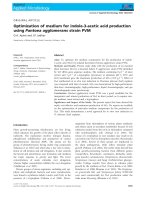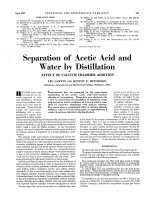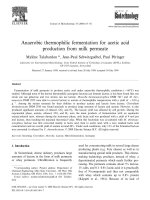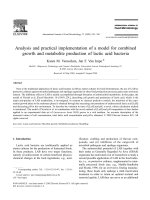Acetic Acid Bacteria 1
Bạn đang xem bản rút gọn của tài liệu. Xem và tải ngay bản đầy đủ của tài liệu tại đây (654.01 KB, 4 trang )
Abstract—
According to FDA (Food and Drug Administration of
the United States), vinegar is definedas a sour liquid containing at
least 4 grams acetic acid in 100 cubic centimeter (4% solution of
acetic acid) of solution that is produced from sugary materials by
alcoholic fermentation. In the base of microbial starters, vinegars
could be contained of more than 50 types of volatile and aromatic
substances that responsible for their sweet taste and smelling.
Recently the vinegar industry has a great proportion in agriculture,
food and microbial biotechnology. The acetic acid bacteria are from
the family Acetobacteraceae. Regarding to the latest version of
Bergy’s Mannual of Systematic Bacteriology that has categorized
bacteria in the base of their 16s RNA differences, the most important
acetic acid genera are included Acetobacter (genus I),
Gluconacetobacter (genus VIII) and Gluconobacter (genus IX). The
genus Acetobacter that is primarily used in vinegar manufacturing
plants is a gram negative, obligate aerobe coccus or rod shaped
bacterium with the size 0.6 - 0.8 X 1.0 - 4.0 µm, nonmotile or motile
with peritrichous flagella and catalase positive – oxidase negative
biochemically.
Some strains are overoxidizer that could convert acetic acid to
carbon dioxide and water.In this research one Acetobacter native
strain with high acetic acid productivity was isolated from Iranian
white – red cherry. We used two specific culture media include Carr
medium [yeast extract, 3%; ethanol, 2% (v/v); bromocresol green,
0.002%; agar, 2% and distilled water, 1000 ml], Frateur medium
[yeast extract, 10 g/l; CaCO3, 20 g/l; ethanol, 20 g/l; agar, 20 g/l and
distilled water, 1000 ml] and an industrial culture medium. In
addition to high acetic acid production and high growth rate, this
strain had a good tolerance against ethanol concentration that was
examined using modified Carr media with 5%, 7% and 9% ethanol
concentrations. While the industrial strains of acetic acid bacteria
grow in the thermal range of 28 – 30 oC, this strain was adapted for
growth in 34 – 36 oC after 96 hours incubation period. These
dramatic characteristics suggest a potential biotechnological strain in
production of cherry vinegar with a sweet smell and different
nutritional properties in comparison to recent vinegar types. The lack
of growth after 24, 48 and 72 hours incubation at 34 – 36 oC and the
growth after 96 hours indicates a good and fast thermal flexibility of
K. Beheshti Maal is with Department of Microbiology, Islamic Azad
University of Falavarjan, Falavarjan 84515/155, Esfahan, Iran (Corresponding
author, telefax: +98-335-322-0136; e-mail: ).
R. Shafiee is with Pars Yeema Biotechnologists Co. Isfahan Science and
Technology Town (ISTT), Esfahan 84155-666, Iran (e-mail:
).
this strain as a significant characteristic of biotechnological and
industrial strains.
Keywords—
Acetobacte, acetic acid bacteria, white – red cherry,
food and agriculture biotechnology, industrial fermentation, vinegar.
I. I
NTRODUCTION
INEGAR is defined as a 4% acetic acid solution that is
originated from an alcoholic fermentation processing
using sugary substances [1] – [4]. Recently the vinegar
industry has been developed to produce several vinegar types
using various qualified native or engineered acetic acid
bacteria [2]- [3]. As originally defined, the acid acetic bacteria
comprised a group of gram-negative, aerobic, motile rods that
carried out incomplete oxidation of alcohol and sugars,
leading to the accumulation of organic acids as end products.
The acetic acid bacteria (AAB) are heterogenous assemblage
organisms [5] - [6]. There are several genus in AAB group but
Gluconobacter sp. and Acetobacter sp. are more discussed as
bacteria that can produce acetic acid industrially.
Acetic acid bacteria are commonly associated with some
fruits such as grape and are normally present in must
deteriorated fruits. These have more acetic acid bacteria
population whereas unspoiled fruits have less [7].
There are several factors that affect the growth and survival
of AAB that amongst, ethanol concentration, acetic acid
concentration, oxygen, temperature and nutrient availability
are the most important factors that can affect the survival of
AAB.
Acetic acid concentration below 10 g/l is resulted in
significantly increased growth rate (particularly at low ethanol
concentration) above 20 g/l acetic acid, however growth is
severely restricted and virtually inhibited at an acetic acid
concentration in the region of 50 g/l, whatever the amount of
ethanol present [8]. There is no doubt that the presence or
absence of oxygen greatly impacts the growth of acetic acid
bacteria and in industrial vinegar fermentation (wine and
rohm).
Isolation and Identification of an Acetobacter
Strain from Iranian White-Red Cherry with
High Acetic Acid Productivity as a Potential
Strain for Cherry Vinegar Production in Food
and Agriculture Biotechnology
K. Beheshti Maal, and R. Shafiee
V
World Academy of Science, Engineering and Technology 54 2009
201
Most of actic acid bacteria are mesophilic but recently a
novel strain has been isolated which can tolerate up to 40ºC,
this strain can be used for industrial production of vinegar in
regions with warm climates.
Among the most important acetic acid bacteria, the strains
of genus Acetobacter are mainly involved in vinegar
production [5], [9]. Acetobacter is a gram negative, obligate
aerobe coccus or rod shaped bacterium with the size of 0.6 -
0.8 X 1.0 - 4.0 µm, nonmotile or motile with peritrichous
flagella, catalase positive and oxidase negative biochemically.
Some strains are overoxidizer that could convert acetic acid to
carbon dioxide and water. Acetobacter use ethanol as carbon
source preferably and is increased during the wine
fermentation processing [1] - [2], [9] - [10]. Acetobacter
strains have been isolated from several natural origins such as
grape, date and palm resources and coconut [9] and have been
applied for production of several vinegar types from various
substrates e.g. sugarcane [3], rice [8] and balsam [11] - [12].
The aims of this study were characterization of the isolated
strain from novel food and agricultural resources that could
grow at high temperatures and tolerate against high
concentrations of ethanol and produce high levels of acetic
acid.
II. M
ATERIALS AND
M
ETHODS
Preparation of Iranian white – red cherry extract: The
spoilages of Iranian white – red cherry were collected from
several areas in Esfahan, Iran. The samples were placed in a
safe cabinet with good ventilation and at room temperature for
10 days. After appearance of fruit flies around the samples,
the fruits were pressed and scrutinized with a sterile metal
plate and were poured into a sterile 2 liters plastic bottle so
that 2/3 of bottle was filled. The bottle was closed and for
preventing bottle explosion, due to alcoholic fermentation and
gas production, some tiny openings were made in the top of
bottle through a sterile needle. The bottle then was incubated
at 30º C for 4 days. The bottle was being examined every 24
hours according to alcoholic fermentation and sour smelling
appearance.
Isolation of bacterial strain: For isolating bacterial strains
that were responsible for vinegar smelling, 20 ml of Iranian
white-red cherry extract were transferred to sterile tubes
aseptically and centrifuged at 3000 rpm for 5 minutes. The
pellets were injected into industrial culture mediums and
incubated at 30º C with aeration speed of 120 rpm for 7 days.
After enrichment of acetic acid bacteria in mentioned medium,
the isolation process was followed using specific culture
media.
Culture media and ingredients: The industrial culture
medium that was used at the first isolation and enrichment
phase includes yeast extract, 2%; ethanol, 2%; acetic acid, 1%
and distilled water, 1000 ml. At the second isolation phase,
the Carr medium [yeast extract, 3%; agar, 2%; bromocresol
green, 0.002%; ethanol, 2% and distilled water, 1000 ml] and
Frateur medium [yeast extract, 10 g/l; CaCO3, 20 g/l; ethanol,
20 g/l; agar, 20 g/l and distilled water, 1000 ml] and modified
Carr media with 4%, 5%, 6%, 7%, 8%, 9% and 10% ethanol
were used [4].
Characterization and biochemical tests: After isolation of
acetic acid bacteria from Iranian white-red cherry,
macroscopic examinations, microscopic and morphological
properties, gram reaction, oxidase and catalase tests, over
oxidation and lactate utilization capability on Carr medium
were investigated.
Titration assay and measurement of acetic acid
percentage: The phenol phetalein reagent [phenol phetalein,
0.1 g; ethanol, 60 g and distilled water, 40 g] and 0.5 normal
NaOH [NaOH, 20 g and distilled water 1000 ml] were made.
For titration assay, 5 ml of culture solution were being added
to a flask and after addition of 20 ml distilled water and 5
drops phenol phetalein, the amount of acetic acid in solution
was being titrated.
Bacterial growth: Bacterial growth was quantified by
measuring the absorbance of industrial culture media at 540
nm.
Measurement of the tolerance of strains against different
ethanol concentrations: The tolerance of isolated strain to
ethanol concentration stress was investigated using modified
Carr media with 4%, 5%, 6%, 7%, 8%, 9% and 10% ethanol
at 30º C and after 24 and 48 hours incubation periods.
Assessment of stains in growth at extreme like conditions:
The isolated strain was cultured in modified Carr media using
5%, 7% and 9% ethanol concentrations and at high unusual
temperatures, 34 ºC and 36 ºC, simultaneously.
III. R
ESULTS
The industrial culture media after 24, 48, 72, 96, 120, 144
and 168 hours incubation at 30º C and with 120 rpm aeration
speed were examined according to their acetic acid production
by titration assay and their turbidity due to bacterial growth.
The results showed their acetic acid percentage after
mentioned incubation periods were 2%, 2.3%, 3.6%, 5.4%,
6.5%, 7.3%, 9.5% respectively as are shown in Fig. 1.
The bacteria were cultured from industrial culture media to
Carr medium and after 24 hours incubation at 30º C showed
tiny blue conducted smooth colonies with shiny reflex and
after 48 hours were initiating to convert the color of the Carr
medium to yellowish indicating that isolated strain was an
acid producing bacterium. Microscopic examinations
confirmed that this strain was a gram negative coccobacillus
to rod with mono, diplo and streptobacillus arrangements.
Biochemical tests showed that the catalase was positive and
the oxidase was negative. The next examinations in measuring
the ethanol tolerance of isolated strain showed that it could be
cultured in different ethanol concentrations, 4%-10%, in
modified Carr media after 24 and 48 hours incubation periods
and was capable to produce acetic acid increasingly (Table I
and Table II).
World Academy of Science, Engineering and Technology 54 2009
202
TABLE I
G
ROWTH AND
A
CETIC
A
CID
P
RODUCTION IN
D
IFFERENT
E
THANOL
C
ONCENTRATION AT
30
º AFTER
24
H
OURS
Time 24 Hours
Ethanol % 4 5 6 7 8 9 10
Growth +4 +4 +3 +2 - - -
Acid
Production
+4
+4
+3
+2
-
-
-
TABLE II
G
ROWTH AND
A
CETIC
A
CID
P
RODUCTION IN
D
IFFERENT
E
THANOL
C
ONCENTRATION AT
30
º AFTER
48
H
OURS
Time 48 Hours
Ethanol % 4 5 6 7 8 9 10
Growth +4 +4 +4 +4 +3 +2 +1
Acid
Production
+4
+4
+4
+4
+3
+2
+1
Fig. 1 The high acetic acid productivity of Acetobacter strain isolated
from Iranian white red cherry after 24, 48, 72, 96, 120, 144 1nd 168
hours at 30 oC and 120 RPM aeration speed
Fig. 2 The tolerance of Acetobacter strain isolated from Iranian white
red cherry against increasing ethanol concentrations in modified Carr
mediums at 30 oC. Series 1: after 24 hours, Series 2: after 48 hours
and series 3: after 72 hours, C: control
Fig. 3 The interaction of tolerance to ethanol shock and critical
temperature after 24, 48, 72 and 96 hours incubation at 34 oC in
Acetobacter strain isolated from Iranian white red cherry. 5: ethanol
5%, 7: ethanol 7%, 9: ethanol 9% and C: control
Fig. 4 The interaction of tolerance to ethanol shock and critical
temperature after 24, 48, 72 and 96 hours incubation at 36 oC in
Acetobacter strain isolated from Iranian white red cherry. 5: ethanol
5%, 7: ethanol 7%, 9: ethanol 9% and C: control
The growth at Frateur medium at 30º C was occurred after
96 hours so that around the colonies had been transparent
confirming that the isolated strain has dissolved the CaCO
3
and was belonged to acetic acid bacteria.
This strain grew on modified Carr media with 4%, 5%, 6%
and 7% ethanol after surprisingly unexpected 24 hours
incubation period with the growth rate of 4+, 4+, 3+ and 2+
respectively in comparison to control, Carr medium. Also this
strain grew on modified Carr media with 8%, 9% and 10%
ethanol after 48 hour’s incubation period with the growth rate
of 3+, 2+ and 1+ respectively.
World Academy of Science, Engineering and Technology 54 2009
203
TABLE III
G
ROWTH AND
A
CETIC
A
CID
P
RODUCTION OF
I
SOLATED
B
ACTERIA AT
34
O
C
AFTER
96
H
OURS
Temperature 34
o
C
Ethanol % 5 6 9
Growth +2 +2 +2
Acid
Production
+4
+4
+4
TABLE IV
G
ROWTH AND
A
CETIC
A
CID
P
RODUCTION OF
I
SOLATED
B
ACTERIA AT
36
O
C
AFTER
96
H
OURS
Temperature 36
o
C
Ethanol % 5 6 9
Growth +1 +1 +1
Acid
Production
+2
+2
+2
The results of the tolerance tests against ethanol shock are
shown in Fig. 2. The cultivation of isolated strain in modified
Carr media with 5%, 7% and 9% ethanol at unusual 34 ºC
(Table III) and 36 ºC (Table IV) temperatures showed that in
all ethanol concentrations after 24, 48 and 72 hours incubation
at 34 ºC there was no growth observed but after 96 hours a 4+
growth rate was shown. Also in all ethanol concentrations
after 24, 48 and 72 hours incubation at 36 ºC there was no
growth observed but after 96 hours a +2 growth rate was
shown.
The results of interactions between ethanol concentrations
and critical temperatures and their relation with the growth
rate of isolated Acetobacter strain from Iranian white – red
cherry are indicated in Figs. 3 and 4.
IV. D
ISCUSSION
According to Kocher et al, vinegar can be produced using
sugarcane juice and Acetobacter aceti at usual temperature,
30º C [3]. Gullo et al, Giudici et al and Falcone et al have
showed that balsamic materials can be applied to produce
traditional balsamic vinegar using modern fermentation
methods with high quality and sensorial properties [7], [11] –
[12]. Nanda et al have reported that rice vinegar (Komesu)
and unpolished rice vinegar (kurosu) could be made using
acetic acid bacteria and have isolated and characterized
responsible strains [8]. Recently Kadere et al have isolated
and identified Acetobacter and Gluconobacter genera from
coconut. The isolated Acetobacter strain in that research has
been cultured at 40 ºC but they have not reported pothentials
of mentioned strain against ethanol stress [9].
In this research study, we isolated an Acetobacter native
strain with high acetic acid productivity from Iranian white –
red cherry, a delicious and favourable summer fruit that is
very sensitive to decay by microorganisms. This strain showed
9.5% acetic acid production after one week incubation that is
a very good characteristic in producing vinegar in a short
period of time in comparison to vinegar manufacturing time of
acetic acid bacteria that is 14 – 30 days routinely [ ]. Passage
of the pure strains to industrial culture medium made a
delicious cherry vinegar with a sweet smell and different
nutritional properties nearby recent vinegar types. In addition
to high acetic acid productivity, this Acetobacter strain was
capable of tolerating 5% - 9% ethanol concentration shocks
and high temperatures of 34 – 36 ºC simultaneously, that
suggests a proper strain in the field of industrial microbiology
and microbial biotechnology. The experiments showedthat,
the speed and type of aeration are so important factors in
growth and then acetic acid production by isolated
Acetobacter strain from Iranian white – red cherry. The
interaction effects of ethanol concentrations and temperature
on growth and acetic acid production of this strain suggests
that the concentration of ethanol influences the temperature
tolerance of this isolate so that with the increase of ethanol
concentration, the sensitivity of strain to high temperature is
increased and the bacterium needs more time to adapt to new
stress conditions i.e. the lag period of growth curve is
increased.
In conclusion, this is the first report of Acetobacter
isolation from a certain cherry, Iranian white – red cherry.
This strain could be a potential strain for production of new
vinegar type with a new and desirable taste, cherry vinegar,
and could use the spoilage of this fruit as substrate to preserve
the bioenvironment from food spoilage contaminations.
R
EFERENCES
[1] A. Joyeux, S. Lafon-Lafourcade and P. Ribereau-Gayon, “Evolution of
acetic acid bacteria during fermentation and storage of wine,” Appl.
Environ. Microbiol., vol. 48, 1984, pp.153-156.
[2] G. S. Drydale and G. H. Fleet, “Acetic acid bacteria in som Australian
wines,” Food Technol. Austr., vol. 37, 1985, pp.17-20.
[3] G. S. Kocher, K. L. Kalra and R. P. Phutela, “Comparative production of
sugarcane vinegar by different immobilization techniques,” J. Inst.
Brew., vol. 112, 2006, pp.264-266.
[4] J. G. Holt, N. R. Krieg, P. H. A. Sneath, J. T. Staley and S. T. Williams,
“Bergey’s Manual of Determinative Bacteriology, New York, Williams
& Wilkins, 1994, pp.267-279.
[5] S. J. Sokollek, C. Hertel and W. P. Hammes, “Cultivation and
preservation of vinegar bacteria,” J. Biotechnol., vol. 60, 1998, pp.195-
206.
[6] T. D. Brock, M. T. Madigan, J. M. Martinko and J. Parker, “Biology of
Microorganisms” London, Prentice Hall International Editions, 1994,
pp. 361-397.
[7] M. Gullo and P. Giudici, “Acetic acid in traditional balsamic vinegar,
phenotypic traits relevant for starter cultures selection,” Int. J. Food
Microbiol., vol. 125, 2008, pp.46-53.
[8] K. Nanda, M. Taniguchi, S. Ujike, N. Ishihara, H. Mori, H. Ono and Y.
Murooka, “Characterization of acetic acid bacteria in traditional acetic
acid fermentation of rice vinegar (komesu) and unpolished rice vinegar
(kurosu) produced in Japan,” Appl. Environ. Microbiol., vol. 67, 2001,
pp.986-990.
[9] T. T. Kadere, T. Miamoto, R. K. Oniang’o, P. M. Kutima and S. M.
Njoroge, “Isolation and identification of genera Acetobacter and
Gluconobacter in coconut toddy (mnazi),” Afr. J. of Biotechnol., vol. 7,
2008, pp. 2963-2971.
[10] W. J. Du Toit and M. G. Lambrechts, “The enumeration an identification
of acetic acid bacteria from South African red wine fermentations,” Int.
J. Food Microbiol., vol. 74, 2002, pp.57-64.
[11] P. Giudici and G. Rinaldi, “A theoretical model to predict the age of
traditional balsamic vinegar, J. Food Eng., vol. 82, 2007, pp.121-127.
[12] P.M. Falcone and P. Giudici, “Molecular size and molecular size
distribution affecting traditional balsamic vinegar aging,” J. Agric. Food
Chem., Vol. 56, 2008, pp.7057-7066.
World Academy of Science, Engineering and Technology 54 2009
204









